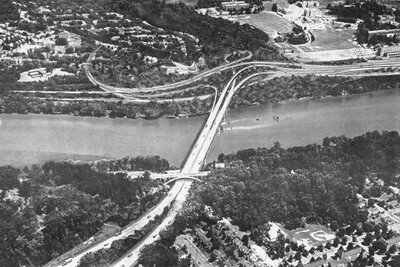
A down sized, down scaled highway system
It eliminated the high capacity (8 lane) cross town I-66 North Leg in a new swath alongside Florida Avenue and U Street, replacing said with a 4 lane depressed express street beneath Florida Avenue, ascending to grade at U Street though with depressed underpasses.
It eliminated the high capacity East Leg of the Inner Loop alongside 11th Street NE/SE, effectively replacing it with a spur along Eastern Avenue NE to the I-95 Northeastern Freeway.
It eliminated the Three Sisters Bridge
at page 25:
In the 1959 plan, Three Sisters Bridge was part of an intermediate loop (located between the Capital Beltway and the proposed inner loop) that virtually circled the city. The Agency's studies show no need for the portion of the intermediate loop between the Potomac Rover and The Soldiers Home area. Standing alone, the only purpose of Three Sisters would be to bring trucks and additional auto traffic from Fairfax and Arlington Counties into downtown. For that purpose the bridge is not required.
As of 1957, there were a total of 22 bridge lanes across the Potomac. Projects now under construction, or recently completed, will nearly double the number of lanes, as the following table shows:
The above table does not include the Old Highway Bridge, though the Virginia Department of Highways proposes that the bridge be used with reversible lanes. This would add still another two lanes in each direction for peak traffic.
The Agency proposes two rail rapid transit lines to Virginia, one of which would serve the Three Sisters Bridge corridor. Rapid transit service would not have have been provided in this corridor under the 1959 plan. With such service available, in 1980 a total of over 30,000 people - many of whom would otherwise be using their autos -- would use public transportation from Virginia into the District in the morning peak hour. This is 18,000 more people than use such transportation today, enough to fill 12 bridge lanes. Figure 14 shows the difference in growth of vehicular traffic across the Potomac and compares that with present traffic needs.
The result, as the following table shows, is that under the plan recommended by the Agency, central bridge capacity will be adequate for the needs of motorists in 1980 without Three Sisters Bridge.
 This letter of John F. Kennedy illustrates a further evolution of his administration's freeway plans for Washington, D.C.
This letter of John F. Kennedy illustrates a further evolution of his administration's freeway plans for Washington, D.C.
“…I noted that certain portions of the highway network within the District of Columbia
The re-examination should focus upon the sections of the highway plans which have from the beginning been the most uncertain and the most controversial- the North Leg of the Inner Loop and the Three Sisters Bridge, both of which involve the manner in which necessarily involve a re-study of those additional portions of the plan which are directly affected by the conclusions reached in the re-examination…”
“ the very large part of the highway program which is not under study can go forward as scheduled.”- John F. Kennedy letter June 1, 1963Notably the June 1, 1963 JFK letter has him discuss the I-66 North Leg and the [I-266] Three Sisters Bridge as controversial and in need of further study.
Since his Administration’s November 1, 1962 report had down-scaled the former while unequivocally excluding the latter altogether, his June 1, 1963 letter can be taken to suggest that JFK had become receptive to considering some sort of road alternative to the previous North leg proposals, and to the Three Sisters Bridge in some form as parts of the future Washington, D.C. road network.






No comments:
Post a Comment